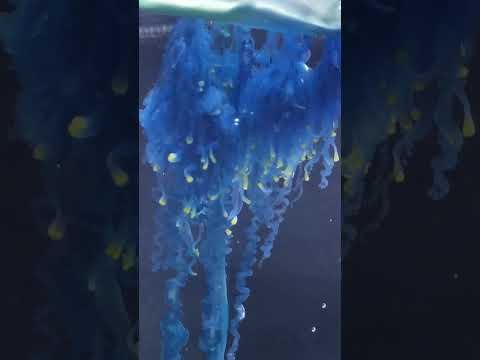A team of university students in Japan identified an entirely new species of the mighty Portuguese Man O’War. Described in a study recently published in the journal Frontiers in Marine Science, the creature’s distinct features and fearsome venom have earned it a name that honors a famous 16th century samurai warrior.
It’s easy to mistake the Portuguese Man O’War (Physalia physalis) for a jellyfish. After all, it features a squishy “head” and venomous tendrils extending as far as 100 feet down into the ocean waters. These tentacles contain a potent neurotoxin that immobilizes its prey—as well as injure thousands of beachgoers around the world every year. But while the Man O’War (also known as a bluebottle) resembles a jellyfish, it’s actually an evolutionary relative known as a siphonophore. Instead of a single animal, siphonophores are composed of individual, genetically identical organisms called zooids. Different zooids focus on specific functions like reproduction, hunting, and digestion, allowing them to operate as a single, collaborative creature.
For around 250 years, marine biologists believed the Man O’War was its own distinct species. However, in June 2025, researchers confirmed that the infamous siphonophore is actually at least four separate species. Now, that number has been upped to five after a student’s unexpected encounter in Japan.

“I was working on a completely different research project around Sendai Bay in the Tohoku region, when I came across this unique ‘jellyfish’ I had never seen around here before,” study co-author Yoshiki Ochiai said in a statement. “I scooped it up, put it in a Ziplock bag, hopped on my scooter, and brought it back to the lab.”
The animal’s arguably most striking feature was its strikingly cobalt blue pneumatophore. This gas-filled bladder allows it to continually float on the ocean’s surface, while its lengthy tentacles trawl along for prey. Ochiai showed the find to marine ecologist Chanikarn Yongstar, who helped describe and record the animal’s morphology.
“I looked at each individual part, comparing its appearance to old tomes where scholars drew out the jellyfish anatomy by hand,” said Yongstar. “A real challenge when you look at just how many tangled parts it has.”
Before their examination, biologists thought only one Man O’War now known as Physalia utriculus swam in the region between Okinawa and Sagami Bay off Japan’s eastern coast. They soon realized the area actually has been home to two separate species this entire time.
The latest discovery is now classified as Physalia mikazuki, which translates to, “crescent helmet Man O’War.” The name is an ode to Date Masamune who lived from 1567-1636 CE. Masamune was one of the city of Sendai’s feudal lords, or daimyō, and displayed a recognizable crescent moon on his helmet. Also known as “One-Eyed Dragon of Ōshū,” Masamune is a renowned figure in the nation’s history and was even the subject of multiple Japanese period dramas.
In addition to its distinct characteristics, P. mikazuki is the first recorded Physalia sighting that far north. This prompted researchers to wonder about its origins.
“[It] is an exciting finding in and of itself, but we still had questions about how it got here,” added study co-author Kei Chloe Tan.
To investigate, colleagues ran a particle simulation to test P. mikazuki’s possible travel routes atop the ocean currents. These scenarios tracked potential paths over the course of weeks or even months based on environmental factors like current speed, water temperatures, and weather patterns. The results indicate P. mikazuki likely followed the warm and powerful Kuroshio Current. The current has begun to extend further north in conjunction with high ocean-surface temperature anomalies in the Pacific Ocean. Although the first of its kind to be documented, the planet’s shifting climate suggests it will be far from the last P. mikazuki sighting.



